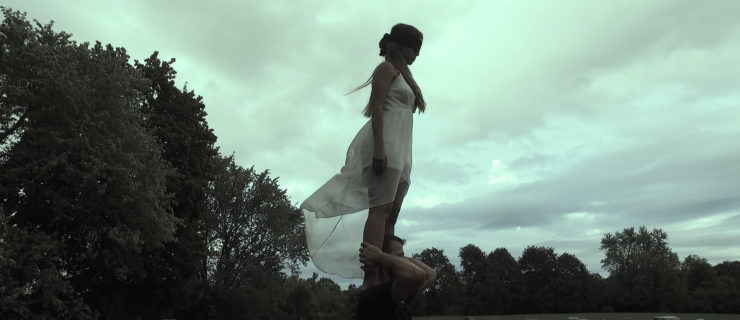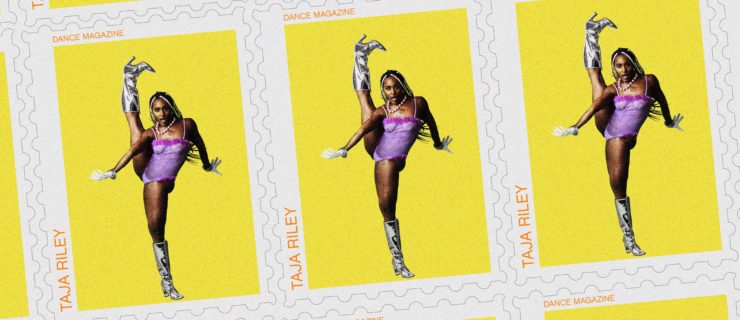Barriers & Bias: What It's Like for Immigrant Dance Artists
Hussein Smko premiered Ballade: The Rain Song at the 2017 Battery Dance Festival, on a platform with a view of the Statue of Liberty. There couldn’t have been a better backdrop. The work pairs Smko’s unique fusion of contemporary dance and hip hop with powerful spoken word read by journalist and Iraqi-American refugee Riyadh Mohammed. With the icon of freedom behind them, their performance drew on their experiences as Muslim immigrants to this country and channeled their resistance to Islamophobia.
“The work might be sensitive,” says Smko, an Iraqi of Arab-Kurdish roots, “but it’s what we witness and what’s going on, and you need to be aware of it.”
In fact, he moved to the U.S. not only to get top-notch training, but also to challenge prejudice through his art. “I could have done something in Kurdistan,” he says, “but it wouldn’t have been as effective. I came here to give a different image from how Muslims are portrayed.”
Smko is one of thousands of dance artists who have come to America from all parts of the world and represent a panoply of races, faiths and cultures. In an era of escalating hate crimes, new laws and increasingly stringent immigration policies, they face unique challenges.
Assumptions About Identity
After first visiting the U.S. on a scholarship, in 2016 Smko got his green card and moved to New York City, where he dances for Battery Dance Company and makes solo pieces and films. For now, his focus is on creating work that foregrounds his experiences with war and immigration and addresses anti-Muslim prejudice. Yet no artist wants to be pigeonholed. “I don’t want for the rest of my life to do just one thing,” he says.
“The assumption is that if somebody is an immigrant, they are a representative of everyone from their country or their culture—or they have to assimilate,” says Alejandra Duque Cifuentes, the executive director of Dance/NYC. In 2018, the nonprofit service organization released two studies on foreign-born dance artists in New York City, and in 2019 produced Advancing Immigrants. Dance. Arts., a survey and analysis on the needs of immigrant dance artists in the New York City area. “What we found is that immigrant dance artists are making dance across all of it: ballet, contemporary, culturally specific forms, fusion work.”
As central as the immigrant experience is to an artist’s identity, many choose not to make it a focus of their choreography. Modern dancer Peiling Kao, for example, emigrated from Taiwan in 2007. Though her work may not overtly address political or cultural issues, her Asian identity is sometimes regarded as “other.” She experienced this during her 2016 participation in Hope Mohr Dance’s Bridge Project: Ten Artists Respond to Locus, in which the dancemakers were inspired by Trisha Brown’s 1975 solo.
 Peiling Kao
Peiling Kao
Marley Aiu, Courtesy Kao
“When Trisha Brown choreographed Locus,” Kao explains, “one of her prompts was to help her to understand more of her movement vocabulary, to understand more of herself as a mover. I thought, Wow, I can use that as a prompt too.” So Kao, who trained in ballet, modern and Chinese dance forms, incorporated elements of classical Chinese movement into her interpretation.
“In the post-show discussion, an audience member asked me if I am trying to empower my Asian identity,” recalls Kao, now 47 and an assistant professor of dance at the University of Hawai’i at Manoa. “It made me wonder, Why haven’t you seen me as a Taiwanese until you see me do Asian movement? Is my yellowness erased when I do modern, but when I do a gesture of Chinese dance, somehow my yellowness becomes even more yellow?”
Assumptions about who immigrants are based on their country of origin or their ethnicity can impact performance opportunities, as well. “A presenter might be more reluctant if they don’t already have a huge following,” says Cifuentes. “Or presenters say, ‘We already have the Latino for this season.’ ”
Barriers to Entry
In addition to the costs of training and rehearsal space that all dancers and choreographers contend with, immigrant artists tend to bear daunting financial and social burdens, says Cifuentes. “There are lawyer costs, visa costs, language barriers, social media harassment, and they often don’t know what resources they can access,” she says. “And if they are undocumented, they might face deportation.”
Those anxieties are a constant presence in Gabriel Mata’s life. Mata migrated from Mexico to Southern California at age 5 with his mother and sister, and only learned he was undocumented at 16, when he couldn’t get a job because he had no Social Security number.
“It came as a shock,” he remembers. “I navigated in a limbo state, and dance was a great way to get out of my head.” In solos like Dreaming, which blend spoken word and modern dance, “I share my personal narrative as well as financial insecurities from being an immigrant,” he says. “I also question notions of citizenship.”
Receiving DACA (Deferred Action for Childhood Arrivals) status at 21 afforded Mata work eligibility, a driver’s license and access to higher education, but his residency remains uncertain, even though he is married to an American citizen. His experience directly informs not only the content of his work, but also its format: Solos are portable and inexpensive to create, and that helps Mata save for expenses like the biennial $495 DACA renewal fee.
“I can’t have a five-year plan to develop as an artist,” says Mata, now 28 and enrolled in the MFA program at the University of Maryland, College Park. “How will I be financially? I just don’t know. It’s just living day by day.”
 Gabriel Mata
Gabriel Mata
Hillary Goidell
Some immigrant dance artists are also ineligible for certain government and private grants that require U.S. citizenship. Additionally, there may also be insufficient social resources that take into account their unique needs, such as language services and fees associated with immigration.
While Cifuentes cites the New York Foundation for the Arts and the Center for Traditional Music and Dance as notable resources, she says, “by and large, there isn’t intentional support for immigrant dance artists.” Or, as Mata puts it, “As immigrants, we get the scraps of the scraps.”
The Bias Against Minorities
Immigrants who are perceived as people of color experience additional discrimination, says Cifuentes. Over a three-year period, the number of Muslim refugees to the U.S. has been decreased by 91 percent. And over the past two years, the U.S. government has put DACA protections in limbo and instituted “extreme vetting” procedures at the borders, such as the January 2020 questioning by the Customs and Border Protection agents of Iranian-Americans returning from abroad.
Contrast that with Pascal Rioult’s experience. “I was lucky, being a Western European citizen and white. Getting a green card was a really easy process,” says the New York City–based choreographer who emigrated from France in 1981, performed with the Martha Graham Dance Company for 10 years and founded RIOULT Dance NY in 1994. “That is not the case for a lot of other people, and that’s unfair.”
Well aware of his privilege, he is trying to increase equity with a youth program at Rioult Dance Center in Astoria, Queens, an exceptionally diverse neighborhood that is home to people from nearly 100 countries.
“We have kids from all different ethnicities,” he says. “We hope that training them from the bottom up will increase diversity in dance, and that eventually they will start to funnel into the company.”
 Pascal Rioult leading a rehearsal
Pascal Rioult leading a rehearsal
Sofia Negron, Courtesy Rioult
New Ideas Become “American”
Countless influential dance artists were and are immigrants, from George Balanchine and José Limón to Ephrat Asherie and nora chipaumire. “Immigrant dancemakers have been vital to what we know as dance today,” Cifuentes says.
Dance/NYC sees immigrant artists as a boon to American dance, and among its recommendations for fostering inclusion and equity are field-wide education on immigrant-rights issues and implicit bias, bringing more immigrant artists onto funding panels, and encouraging leading organizations to provide mentoring.
Every immigrant dance artist brings with them their unique perspective as an individual and a cultural legacy of their country of origin. Over time, their contributions get absorbed into American dance culture, and it’s easy to forget that they originally brought their ideas and identities from other parts of the world.
As Smko sees it, that’s simply one aspect of dance’s power as an international language. “The idea behind the movement is to touch your mind, regardless of who you are,” says Smko. “It’s made for humans.”





